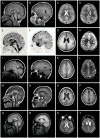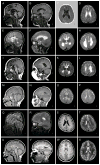The core FOXG1 syndrome phenotype consists of postnatal microcephaly, severe mental retardation, absent language, dyskinesia, and corpus callosum hypogenesis
- PMID: 21441262
- PMCID: PMC5522617
- DOI: 10.1136/jmg.2010.087528
The core FOXG1 syndrome phenotype consists of postnatal microcephaly, severe mental retardation, absent language, dyskinesia, and corpus callosum hypogenesis
Abstract
Background: Submicroscopic deletions in 14q12 spanning FOXG1 or intragenic mutations have been reported in patients with a developmental disorder described as a congenital variant of Rett syndrome. This study aimed to further characterise and delineate the phenotype of FOXG1 mutation positive patients.
Method: The study mapped the breakpoints of a 2;14 translocation by fluorescence in situ hybridisation and analysed three chromosome rearrangements in 14q12 by cytogenetic analysis and/or array comparative genomic hybridisation. The FOXG1 gene was sequenced in 210 patients, including 129 patients with unexplained developmental disorders and 81 MECP2 mutation negative individuals.
Results: One known mutation, seen in two patients, and nine novel mutations of FOXG1 including two deletions, two chromosome rearrangements disrupting or displacing putative cis-regulatory elements from FOXG1, and seven sequence changes, are reported. Analysis of 11 patients in this study, and a further 15 patients reported in the literature, demonstrates a complex constellation of features including mild postnatal growth deficiency, severe postnatal microcephaly, severe mental retardation with absent language development, deficient social reciprocity resembling autism, combined stereotypies and frank dyskinesias, epilepsy, poor sleep patterns, irritability in infancy, unexplained episodes of crying, recurrent aspiration, and gastro-oesophageal reflux. Brain imaging studies reveal simplified gyral pattern and reduced white matter volume in the frontal lobes, corpus callosum hypogenesis, and variable mild frontal pachgyria.
Conclusions: These findings have significantly expanded the number of FOXG1 mutations and identified two affecting possible cis-regulatory elements. While the phenotype of the patients overlaps both classic and congenital Rett syndrome, extensive clinical evaluation demonstrates a distinctive and clinically recognisable phenotype which the authors suggest designating as the FOXG1 syndrome.
Conflict of interest statement
None.
Figures




Similar articles
-
14q12 microdeletions excluding FOXG1 give rise to a congenital variant Rett syndrome-like phenotype.Eur J Hum Genet. 2013 May;21(5):522-7. doi: 10.1038/ejhg.2012.208. Epub 2012 Sep 12. Eur J Hum Genet. 2013. PMID: 22968132 Free PMC article.
-
14q12 and severe Rett-like phenotypes: new clinical insights and physical mapping of FOXG1-regulatory elements.Eur J Hum Genet. 2012 Dec;20(12):1216-23. doi: 10.1038/ejhg.2012.127. Epub 2012 Jun 27. Eur J Hum Genet. 2012. PMID: 22739344 Free PMC article.
-
Revisiting the phenotype associated with FOXG1 mutations: two novel cases of congenital Rett variant.Neurogenetics. 2010 May;11(2):241-9. doi: 10.1007/s10048-009-0220-2. Epub 2009 Oct 6. Neurogenetics. 2010. PMID: 19806373
-
A FOXG1 mutation in a boy with congenital variant of Rett syndrome.Neurogenetics. 2011 Feb;12(1):1-8. doi: 10.1007/s10048-010-0255-4. Epub 2010 Aug 24. Neurogenetics. 2011. PMID: 20734096 Review.
-
Thin genu of the corpus callosum points to mutation in FOXG1 in a child with acquired microcephaly, trigonocephaly, and intellectual developmental disorder: a case report and review of literature.Eur J Paediatr Neurol. 2014 May;18(3):420-6. doi: 10.1016/j.ejpn.2013.11.010. Epub 2013 Dec 6. Eur J Paediatr Neurol. 2014. PMID: 24388699 Review.
Cited by
-
Epilepsy Characteristics in Neurodevelopmental Disorders: Research from Patient Cohorts and Animal Models Focusing on Autism Spectrum Disorder.Int J Mol Sci. 2022 Sep 16;23(18):10807. doi: 10.3390/ijms231810807. Int J Mol Sci. 2022. PMID: 36142719 Free PMC article. Review.
-
Platelet defects in congenital variant of Rett syndrome patients with FOXG1 mutations or reduced expression due to a position effect at 14q12.Eur J Hum Genet. 2013 Dec;21(12):1349-55. doi: 10.1038/ejhg.2013.86. Epub 2013 May 1. Eur J Hum Genet. 2013. PMID: 23632790 Free PMC article.
-
14q12 microdeletions excluding FOXG1 give rise to a congenital variant Rett syndrome-like phenotype.Eur J Hum Genet. 2013 May;21(5):522-7. doi: 10.1038/ejhg.2012.208. Epub 2012 Sep 12. Eur J Hum Genet. 2013. PMID: 22968132 Free PMC article.
-
The relationship of Rett syndrome and MECP2 disorders to autism.Dialogues Clin Neurosci. 2012 Sep;14(3):253-62. doi: 10.31887/DCNS.2012.14.3/jneul. Dialogues Clin Neurosci. 2012. PMID: 23226951 Free PMC article. Review.
-
Impaired macroglial development and axonal conductivity contributes to the neuropathology of DYRK1A-related intellectual disability syndrome.Sci Rep. 2022 Nov 19;12(1):19912. doi: 10.1038/s41598-022-24284-5. Sci Rep. 2022. PMID: 36402907 Free PMC article.
References
-
- Bisgaard AM, Kirchhoff M, Tumer Z, Jepsen B, Brondum-Nielsen K, Cohen M, Hamborg-Petersen B, Bryndorf T, Tommerup N, Skovby F. Additional chromosomal abnormalities in patients with a previously detected abnormal karyotype, mental retardation, and dysmorphic features. Am J Med Genet A. 2006;140:2180–7. - PubMed
-
- Mencarelli MA, Kleefstra T, Katzaki E, Papa FT, Cohen M, Pfundt R, Ariani F, Meloni I, Mari F, Renieri A. 14q12 Microdeletion syndrome and congenital variant of Rett syndrome. Eur J Med Genet. 2009;52:148–52. - PubMed
-
- Papa FT, Mencarelli MA, Caselli R, Katzaki E, Sampieri K, Meloni I, Ariani F, Longo I, Maggio A, Balestri P, Grosso S, Farnetani MA, Berardi R, Mari F, Renieri A. A 3 Mb deletion in 14q12 causes severe mental retardation, mild facial dysmorphisms and Rett-like features. Am J Med Genet A. 2008;146A:1994–8. - PubMed
-
- Shoichet SA, Kunde SA, Viertel P, Schell-Apacik C, von Voss H, Tommerup N, Ropers HH, Kalscheuer VM. Haploinsufficiency of novel FOXG1B variants in a patient with severe mental retardation, brain malformations and microcephaly. Hum Genet. 2005;117:536–44. - PubMed
Publication types
MeSH terms
Substances
Grants and funding
LinkOut - more resources
Full Text Sources
Medical
Molecular Biology Databases
